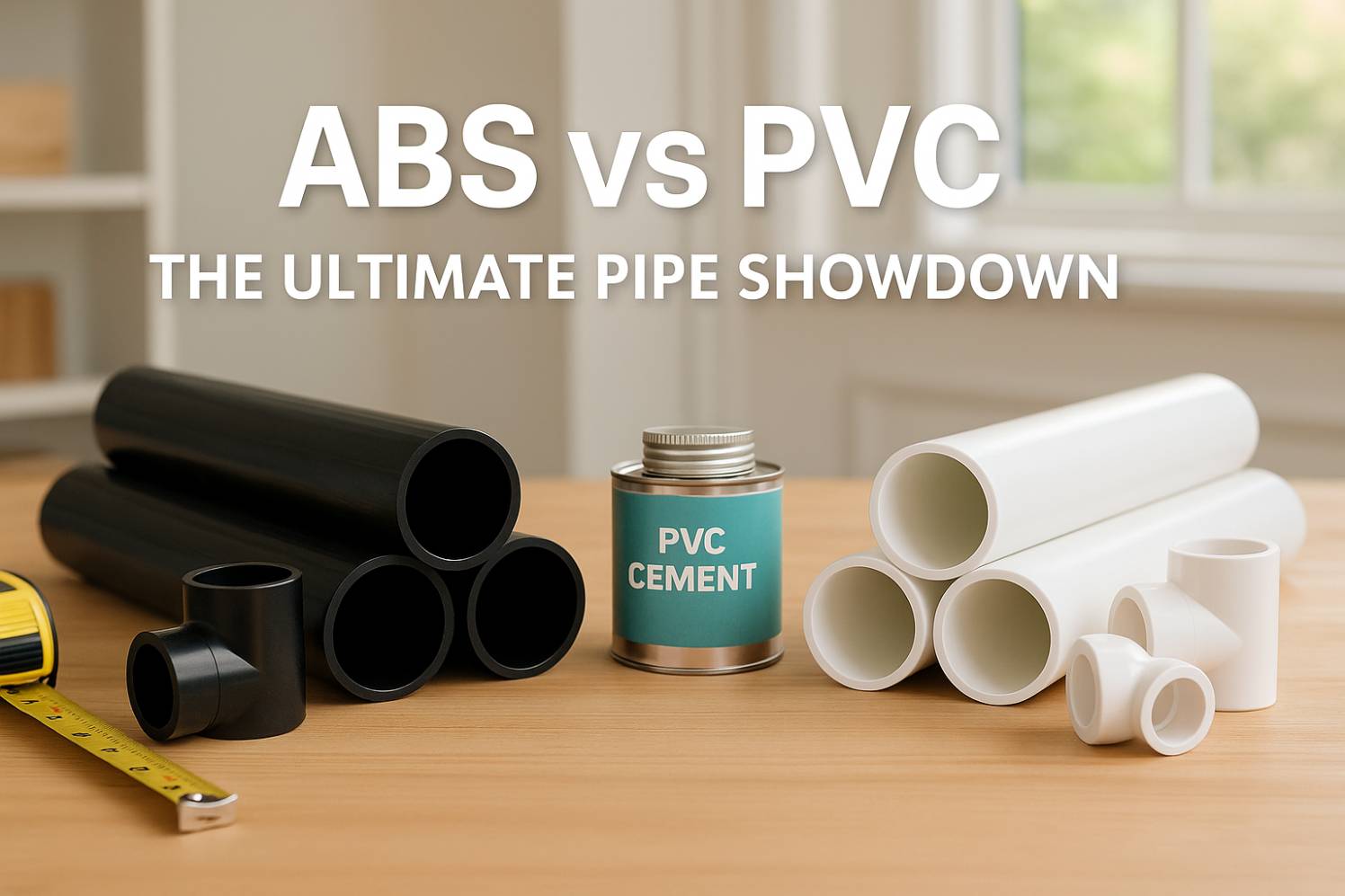I still remember the first time I stood in the plumbing aisle staring at two nearly identical pipes—one black, one white—both promising durability and reliability. The labels read “ABS” and “PVC,” and I had no idea which one to pick. I thought, how different could two plastic pipes really be? Spoiler: very different. After a few plumbing projects (and one leaky mishap), I finally learned what makes the ABS vs PVC debate worth paying attention to.
Here’s my honest, hands-on breakdown of how these two materials compare, how they behave in real-world conditions, and when you should use each one.
What Makes ABS and PVC Pipes So Different?

At a glance, ABS pipes are black, and PVC pipes are usually white or gray. But the color is just the beginning. These two thermoplastics have unique personalities. ABS (Acrylonitrile Butadiene Styrene) is like that friend who can take a hit and laugh it off—it’s tough, impact-resistant, and holds up well in cold temperatures.
On the other hand, PVC (Polyvinyl Chloride) is the more disciplined, composed type. It’s rigid, quieter, and handles sunlight and outdoor conditions better. If you’ve ever installed pipes that run outside, PVC’s UV resistance is a huge bonus.
Here’s a quick comparison for context:
| Feature | ABS | PVC |
| Color | Black | White or gray |
| Impact Strength | High | Moderate |
| Temperature Range | -40°C to 70°C (-40°F to 158°F) | 0°C to 60°C (32°F to 140°F) |
| UV Resistance | Poor | Excellent |
| Installation | Single-step cement | Two-step primer + cement |
| Noise Dampening | Louder | Quieter |
| Contains BPA | Yes | No |
Which One Handles Temperature Better in Real Life?

When I worked on a basement drain line one winter, ABS became my savior. It stayed flexible and strong even in freezing weather. PVC, however, doesn’t enjoy the cold—it gets brittle and can crack if mishandled.
If your pipes live outdoors under the sun, though, PVC wins. ABS warps under UV rays, which makes it a poor choice for outdoor plumbing unless buried or shaded. So, if you’re working in a garage or exposed area, PVC holds its shape much longer.
In short:
- Cold climate or indoor setup? Go with ABS.
- Sunny, outdoor installation? PVC is your best friend.
How Does the ABS vs PVC Installation Process Compare?

When I first glued ABS pipes together, I loved how simple it was—just one special cement, no fuss. With PVC, I quickly learned it’s a two-step process. You need to prime the pipe ends before applying cement. It’s not difficult, but it does take a little longer.
Here’s the thing: ABS’s simplicity saves time, especially when you’re doing a DIY project. But if you prefer ultra-secure joints that can handle more pressure, PVC’s priming step gives it that edge in performance. Both create solid, watertight seals when installed properly—you just have to follow the right method for each.
Is One Quieter or More Durable Than the Other?
If you hate the sound of rushing water echoing through walls, PVC might make you happier. It’s naturally better at muffling noise. My ABS pipes, on the other hand, are a little louder when draining water. It’s not deal-breaking, but noticeable in quiet spaces.
Durability-wise, ABS handles shocks like a champ. If you accidentally drop a heavy tool on it, it usually bends or dents instead of cracking. PVC is stiffer—it resists bending but is more likely to crack under sudden impact.
So, the trade-off is clear:
- ABS: Tough, flexible, and impact-resistant.
- PVC: Quiet, rigid, and better outdoors.
Where Should You Actually Use Each Type?
Here’s how I break it down for real-world projects:
- ABS: I use it for indoor plumbing—especially drain, waste, and vent (DWV) lines. It performs well in basements and crawl spaces where cold temperatures can make other materials brittle.
- PVC: This one rules for outdoor projects, water supply lines, and situations where sunlight exposure is inevitable. It’s also BPA-free, which is a plus if you’re cautious about materials that touch potable water.
And a pro tip—never mix ABS and PVC pipes. Their chemical compositions don’t play nicely, and connecting them can lead to leaks or failure.
How to Choose Between ABS vs PVC for Your Project
Whenever I help friends pick between the two, I tell them to ask three simple questions:
- Where will the pipe go?
Indoors or underground? ABS. Outdoors or exposed to sunlight? PVC. - What’s the temperature range?
Cold basement? ABS. Warm attic or garden area? PVC. - Do you want quick installation or higher pressure resistance?
If you want speed, go with ABS. If you prefer a sturdier, quieter line, PVC wins.
If you keep these questions in mind, you’ll almost never make the wrong choice.
FAQs About ABS vs PVC
1. Can I glue ABS and PVC pipes together?
No—you shouldn’t mix them. They’re chemically different, and standard cements aren’t compatible. There are “transition cements” that claim to bond both, but most building codes discourage using them for permanent plumbing systems.
2. Which is more expensive, ABS or PVC?
PVC pipes are usually cheaper per unit. However, ABS installation can end up being less expensive overall because it skips the primer step. So, project costs can balance out depending on labor and materials.
3. Is ABS safe for drinking water?
ABS is typically not used for potable water systems because it contains BPA, which can leach in certain conditions. PVC, being BPA-free and chemically inert, is the preferred option for water supply lines.
4. Can ABS or PVC handle hot water?
Neither is great for high-heat applications. Both materials start softening above 60–70°C (140–158°F). For hot water systems, CPVC (Chlorinated PVC) or PEX is a much better choice.
Final Thoughts: The Pipe Showdown I Didn’t Expect to Love
Choosing between ABS vs PVC used to feel like splitting hairs—until I realized how much the right choice affects long-term performance. I love ABS for its cold-weather toughness and fast installation, but when it comes to outdoor plumbing, PVC never lets me down.
Here’s my rule of thumb: match the pipe to the environment, not the price tag. The wrong pipe in the wrong place will cost you more down the road.
So next time you’re standing in that aisle, remember: black for the basement, white for the sunshine. Your future leak-free self will thank you.









